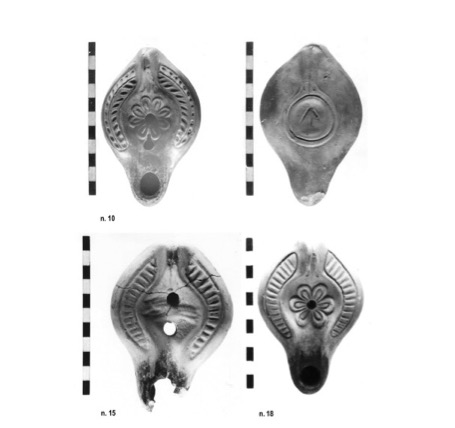African oil lamp (Codula of Fuili)
A clay lamp made of African Terra Sigillata was found (fig. 2) in one of the many caves of Codula of Fuili (fig. 1), in the territory of Dorgali.

The oil lamp is a type of lamp that belongs to the class of lighting furnishings, fed by liquid fuel, mainly oil. In Sardinia, the oldest unequivocal evidence of lamps was found during the Nuraghic age when terracotta boat or “spoon" shaped models were made.
The sample from Codula Fuili, made of orange clay, consists of a circular body, a round spout with traces of blackening, a shoulder adorned with a vegetable motif (palmetto), a grooved handle not protruding from behind. The bottom is slightly concave.

The concave disc, with a double infundibulum, is decorated at the top, according to the interpretation shared by archaeologist Roberto Caprara and Maria Rosaria Manunza, the archaeologist officer of the Archaeological Superintendence Department of Sardinia, with a stylised dolphin darting with its tail up.
This particular kind of motif, inherited from paganism as it is associated with the cult of Apollo and often used in oil lamp decorations (fig. 3), in Christian iconography is linked to the concept of salvation.

This type of lamp produced in central Tunisia, well documented in Sardinia (fig. 4), and widespread throughout the Western Mediterranean (type 2a Pohl/Hayes/Atlas VIII) may be dated within the period of production of this typology from the mid IV to the VI century A.D.
Because of its shape, the mark under its handle and the dolphin, it may be compared with a nearly identical lamp kept at the Civic Museum of Bologna, from which the Bologna specimen differs only because of its smaller size and because of the opposite representation of the subject, on the right, with the tail pointing towards the handle.
Based on some elements, such as a not overly stylised type of dolphin and the type of palmetto, it may be chronologically placed within the period of production of this typology during the sixth century A.D.

The finding is on display in the Archaeological Museum of Dorgali.
Bibliografia
- CARRADA F., Le lucerne, in MARTORELLI R., MUREDDU D. (a cura di), Scavi sotto la chiesa di S. Eulalia a Cagliari. Notizie preliminari, Archeologia medievale, 29, 2002, pp. 318-321.
- MANUNZA M.R., Dorgali, in LILLIU G. (a cura di), L’Antiquarium Arborense e i civici musei archeologici della Sardegna, Oristano, 1988, p. 156.
- PIETRA G., Lucerne tardo antiche dal porto di Olbia, in ArcheoArte, Rivista elettronica di Archeologia e Arte, http://archeoarte.unica.it/2, 2013, pp. 121-139.
- PULACCHINI D., Il museo archeologico di Dorgali, Sardegna Archeologica. Guide e itinerari, 27, Sassari 1998, p. 42.
- SALVI D., Luce sul tempo: la necropoli di Pill’e Matta, Quartucciu, Cagliari 2005.
- SANGIORGI S., Suppellettile da illuminazione, in MARTORELLI R., MUREDDU D. (a cura di), Archeologia urbana a Cagliari. Scavi in Vico III Lanusei (1996-1997), Cagliari 2006, pp. 145-147.

 VR
VR